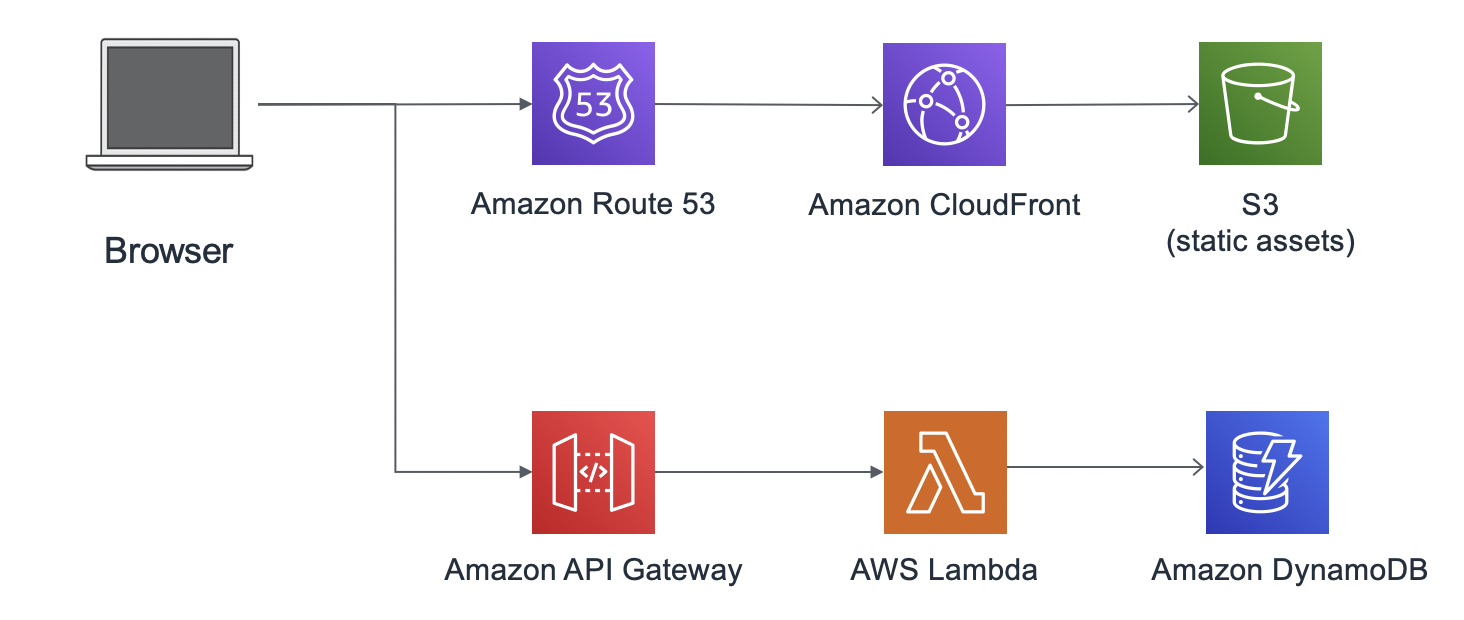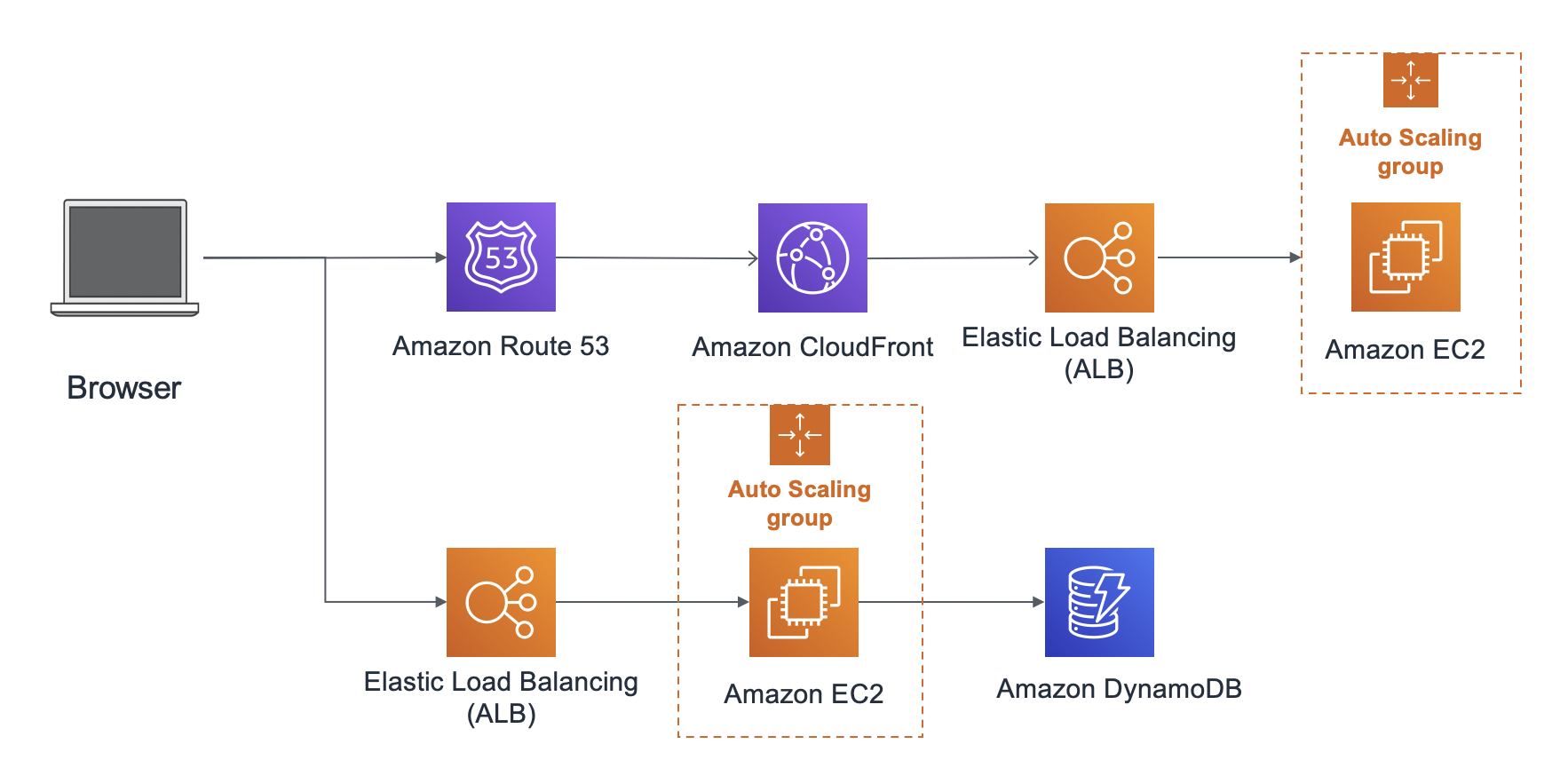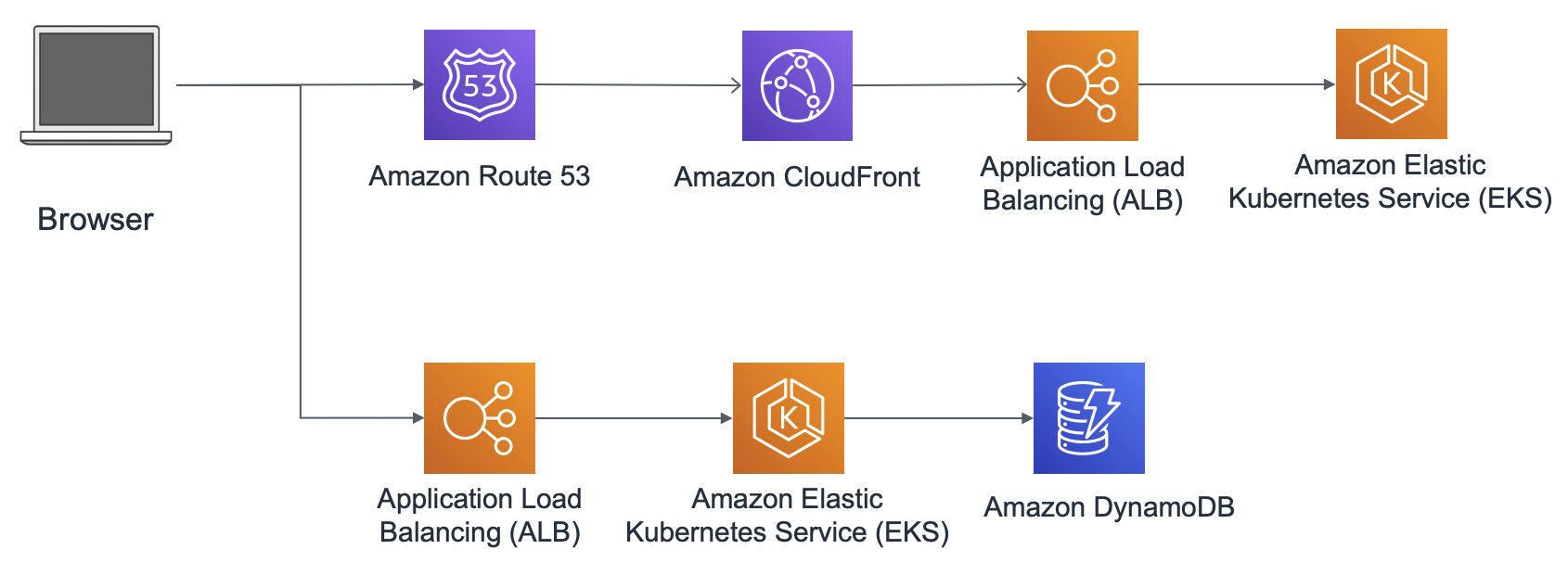中文版本请点击此文档
This repo provides three types of web hosting architecture sample codes. Each of them contains a default example website, so that you could visit directly after the deployment for easy testing. You could also use this script to check how to launch a terraform project in China region. For each architecture, architecture diagram is attached in the corresponding chapter.
- Serverless:Cloudfront + S3 + API Gateway + Lambda + DynamoDB [please check note No.5 first for this architecture]
- EC2: Cloudfront - ALB - EC2 in Auto Scaling Group - DynamoDB
- EKS: EKS for front and backend
Note:
- Terraform could be used in China region too.
- If you have existing terraform scripts that apply to other global AWS regions, you need to revise the scripts to make it work.
- The differences that need to revise mainly includes ARN, service endpoint and region codes etc.
- For detailed service feature difference, please refer to this doc
- For S3 static web hosting, please make sure you contact your local team about ICP recordal first. As this architecture can't help you to obtain ICP recordal. If you need to pass ICP, you will need to deploy on EC2(optiona2) or EKS/ECS(option 3)
- Install and configure AWS CLI
- Have a domain whose first domain has completed the ICP recordal process, as required by local regulation.
- Have an AWS China account (if you would like to apply one, please refer to this page for guidance, China legal entity's business license will be needed)
- the AWS China account has opened the 80、8080、443 ports (blocked by default, use ICP recordal to apply for unblock)
- Apply for SSL certificates in advanced,as Cloudfront in China region doesn't allow default domain and certificate for visiting, for regulation reasons.
- Upload this certificates to IAM,for CloudFront to use (China region doesn't support ACM integration yet -202206 )
- We will not cover more China region introduction in this repo, please check this doc for more information if you are interested to learn more.
# use CLI to upload the SSL certificate
aws iam upload-server-certificate —server-certificate-name CertificateName
--certificate-body file://public_key_certificate_file —private-key file://privatekey.pem
--certificate-chain file://certificate_chain_file —path /cloudfront/<DistributionName>/
Front-end: Cloudfront + S3
Back-end: API Gateway + Lambda
-
Download this repo
git clone https://github.com/aws-samples/web-hosting-architecture-examples-for-china-region-terraform.git cd serverless -
revise variable.tf and replace variables with your own ones
variable "site_domain" { type = string description = "The domain name to use for the static site" default = "example.com" } Note: If you would like to revise the name of DynamoDB tablles, please also revise this value in lambda codes. -
Revise cloudfront.tf, and add your CNAME & certificates
# must have a SSL certificate ready in IAM before you add alias aliases = [ "xxxx.${var.site_domain}" # assume the domain and corresponding cerficiate is example.com, "xxx.example.com" ] viewer_certificate { acm_certificate_arn = "xxxxxx" #Cerficates ARN. To get this value, please upload the certificates to IAM first. ssl_support_method = "sni-only" } Comments the codes that use the default certificate: # viewer_certificate { # cloudfront_default_certificate = true # } -
(Optional) If your DNS host zone has already existed in current AWS accounts, add the below codes to cloudfront.tf, so that terraform could add Cloudfront CNAME records.
# If your DNS host zone has aready existed in current AWS account, use these below codes for terraform to add the cloudfront records. data "aws_route53_zone" "my-domain" { name = "${var.site_domain}" # host zone name private_zone = false } resource "aws_route53_record" "terraform" { zone_id = data.aws_route53_zone.my-domain.zone_id name = "terraform.${var.site_domain}" # revise your own domain type = "A" # records = [aws_s3_bucket.site.website_endpoint] alias { name = aws_cloudfront_distribution.my-domain.domain_name zone_id = data.aws_route53_zone.my-domain.zone_id evaluate_target_health = true } } -
Run Terraform Script
terraform init terraform apply -
Revise
/tutorial/js/config.js, make sure the value ofinvokeUrlis the output ofapi_gateway_endpoint# Download the front-end codes (source S3 bucket is in China region) aws s3 sync s3://tiange-s3-web-hosting/unicorn-web-hosting/ tutorial/ # Revise window._config = { api: { invokeUrl: 'xxxxx' // e.g. https://rc7nyt4tql.execute-api.us-west-2.amazonaws.com/prod', } }; -
Upload your static files to your own S3 bucket
aws s3 sync tutorial/ s3://xxxxx.example.com/ -
Go to API Gateway, and find
/rideresource. In action,chooseenable CORS,and re-deploy the API. -
(If you didn't add ROU53 records in previous steps)please add the CNAME of Cloudfront in your ROUTE53 host zone manually, xxx.example.com --CNAME-- (xxxx.cloudfront.cn)
-
If you need to delete the above resources,run
terraform destroy
Please use your own domain, and S3 bucket endpoint to verify if both URL could be used to visit the example website.
Note: In China, because of regulation requirements,it's expected that you can't use Cloudfront's default domain(xxx.cloudfront.cn) for visiting,this is not an error.
- If there is 404 error code in S3, please check if you have uploaded your static files to S3,and these files are located directly under S3 bucket ,not under ‘tutorial/’. If you would like to add your own prefix, please revise cloudfront origin path accordingly.
- If the S3 endpoint works but your own domain fails to load, check the certificates and ROUTE53 CNAME record.
- If the API Gateway is not working, please check if you have enabled CORS, and whether you have re-deployed the API Gateway.
Front-end: Cloudfront + ALB + EC2 (Nginx as web server) in Auto Scaling Back-end: ALB + EC2 (as app server) in Auto Scaling
-
Download the codes
git clone https://github.com/aws-samples/web-hosting-architecture-examples-for-china-region-terraform.git cd ec2 -
Revise
variable.tfand replace with your own variables, includingkey_name , account_id, ec2_instance_type,site_domain. Note, please DO NOT reviseelb_account_id. -
Revise
web-hosting-s3.tfand add your own CNAME and corresponding certificate.# must have a SSL certificate before you add alias aliases = [ "xxxx.${var.site_domain}" # assume the domain and corresponding cerficiate is example.com,the value here should be "xxx.example.com" ] viewer_certificate { acm_certificate_arn = "xxxxxx" #Certificate ARN. must upload the certificates to IAM first to get this value. ssl_support_method = "sni-only" } Comments those below codes: # viewer_certificate { # cloudfront_default_certificate = true #Use default Certificates # } -
(Optional) If your DNS host zone has already existed in current AWS account, please add below codes to
web-hosting-s3.tfso that terraform could automatically add your Cloudfront CNAME records.# If your DNS host zone has aready existed in current AWS account, use these below codes for terraform to add the cloudfront records. data "aws_route53_zone" "my-domain" { name = "${var.site_domain}" # host zone name private_zone = false } resource "aws_route53_record" "terraform" { zone_id = data.aws_route53_zone.my-domain.zone_id name = "terraform.${var.site_domain}" # Revise with your own domain type = "A" # records = [aws_s3_bucket.site.website_endpoint] alias { name = aws_cloudfront_distribution.my-domain.domain_name zone_id = data.aws_route53_zone.my-domain.zone_id evaluate_target_health = true } } -
Run Terraform script
terraform init terraform apply -
Revise
/tutorial/js/config.jsand make sure the value ofinvokeUrlis the output ofalb_url# Download the front-end codes aws s3 sync s3://tiange-s3-web-hosting/unicorn-web-hosting/ tutorial/ # Revise window._config = { api: { invokeUrl: 'xxxxx' // e.g. https://xxxxxxx.cn-north-1.elb.amazonaws.com.cn:8080', } }; -
After revising, upload the JS file to server. and upload this to your own S3 bucket.
-
Replace the s3 bucket
tiange-s3-web-hostingin the user data with your own bucket, so that the new scaled EC2 will automatically get the latest updated filesaws s3 sync tutorial/ s3://xxxxx.example.com/ -
(If you didn't add ROU53 records in previous steps)please add the CNAME of Cloudfront in your ROUTE53 host zone manually, xxx.example.com --CNAME-- (xxxx.cloudfront.cn)
-
Use
terraform destroyto delete all resources in this step.
Front-end: Cloudfront + ALB + EKS Back-end: ALB + EKS
# download the codes
git clone https://github.com/aws-samples/web-hosting-architecture-examples-for-china-region-terraform.git
cd eks
# terraform
terraform init
terraform apply
# configure kubectl
aws eks --region $(terraform output -raw region) update-kubeconfig --name $(terraform output -raw cluster_name)
# Test
kubectl get node
# Deploy Kubernetes Dashboard
kubectl apply -f dashboard-v2.0.0.yaml
kubectl get pods -n kube-system
kubectl get services -n kube-system
# deploy ALB ingress controller
# refer to https://docs.amazonaws.cn/en_us/eks/latest/userguide/aws-load-balancer-controller.html for local docker images, or the speed may be extremely slow.
# in Beijing region, the docker image should be: image.repository=918309763551.dkr.ecr.cn-north-1.amazonaws.com.cn/amazon/aws-load-balancer-controller:v2.4.0
# Deploy sample Application
# Deploy the back-end
cd ecsdemo-backend
kubectl apply -f ecsdemo-nodejs/deployment.yaml
kubectl apply -f ecsdemo-nodejs/service.yaml
## Check if the deployment succeeds
kubectl get deployment ecsdemo-nodejs
kubectl apply -f ecsdemo-crystal/deployment.yaml
kubectl apply -f ecsdemo-crystal/service.yaml
## Check if the deployment succeeds
kubectl get deployment ecsdemo-crystal
# deploy the front-end, deployment + service + ingress
cd ../ecsdemo-frontend
kubectl apply -f ecsdemo-frontend.yaml
## Check if the deployment is successful
kubectl get deployment ecsdemo-frontend
kubectl get ingress ecsdemo-frontend
# delete if needed
terraform destroy
- Terraform official documentation: https://registry.terraform.io/providers/hashicorp/aws/latest/docs
- S3 web hosting:https://learn.hashicorp.com/tutorials/terraform/cloudflare-static-website?in=terraform/aws
- Serverless web hosting: https://learn.hashicorp.com/tutorials/terraform/lambda-api-gateway?in=terraform/aws
- Cloudfront: https://learn.hashicorp.com/tutorials/terraform/cloudflare-static-website?in=terraform/aws#clone-the-sample-repository
- EKS workshop: https://github.com/aws-samples/eks-workshop-greater-china/tree/master/china/2020_EKS_Launch_Workshop
- EKS terraform: https://learn.hashicorp.com/tutorials/terraform/eks
- EKS ALB: https://docs.amazonaws.cn/en_us/eks/latest/userguide/aws-load-balancer-controller.html
See CONTRIBUTING for more information.
This library is licensed under the MIT-0 License. See the LICENSE file.


